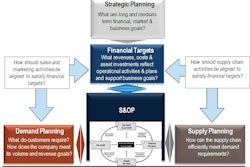
Rising pressures to manage costs, broaden product portfolios and enter new markets are driving the need to better understand the financial implications of supply chain decision-making. Traditional sales and operations planning (S&OP) is insufficient at providing business leaders with insight into the financial trade-offs of critical supply and demand management decisions. Top-performing companies are moving beyond traditional S&OP to more integrated business planning (IBP) in order to confront this challenge.
At its core, integrated business planning (IBP) is a collaborative decision-making process that links strategic, operational and financial objectives, and plans to improve overall business performance (see Figure 1). It relies on participation and input from all facets of the organization, including supply chain, finance, sales and marketing, as well as input from customers.
When implemented effectively, integrated business planning can support sales growth, reduce costs to serve and improve working capital (see Figure 2).
Yet, despite all of the potential benefits to be reaped from IBP, many companies become stuck in the early and mid-stages of IBP maturity and don’t develop crucial IBP practices that help unlock these benefits. Effective IBP is driven by successful implementation of a range of IBP best practices. Developing integrated planning processes throughout the organization, ensuring that the right people are in place and accountable for the planning execution, and the necessary tools and systems are available to fully support the IBP process are fundamental elements that drive IBP performance.
The list below shows sample best practices used by top-performing companies:
- Formal targets with accountability are in place.
- IBP process is senior leadership-owned.
- A formal, defined IBP process is in place.
- The team implementing IBP is cross-functional.
- IBP looks out over an 18+ month period.
- Tools are in place to provide what-if modeling support for IBP decisions.
- IBP plans feed directly into core enterprise resource planning (ERP) and enterprise project management (EPM) systems.
- Tools are in place to provide IBP reporting and performance dashboards.
Implementing and realizing best-in-class capabilities and the benefits of IBP takes dedicated, committed resources, and perhaps more importantly, it takes time. Most successful IBP implementations consist of three primary phases:
- Preparation. Start by executing a current-state assessment, leveraging best practices and benchmarks.
- Pilot. Pilot cycles allow organizations to pressure test the new design, and make any necessary improvements or adjustments along the way.
- Continuous improvement. After the pilot phase is complete, companies traditionally shift their focus on how to best measure performance going forward.
IBP is an iterative process that gets better over time. While it may not be perfect the first time through, if implemented effectively and run efficiently, IBP can be a powerful tool for driving vastly improved business results and creating a sustainable competitive advantage in the marketplace.
The complete research described is available, with registration, here. Download the full report to learn more about trends, best practices and metrics that help organizations develop their integrated business planning capabilities.


















